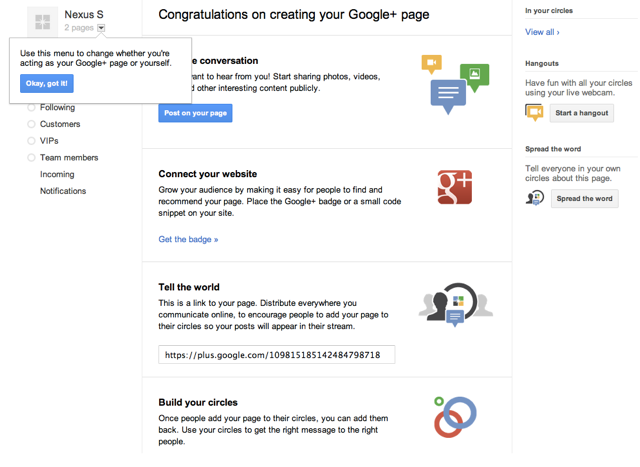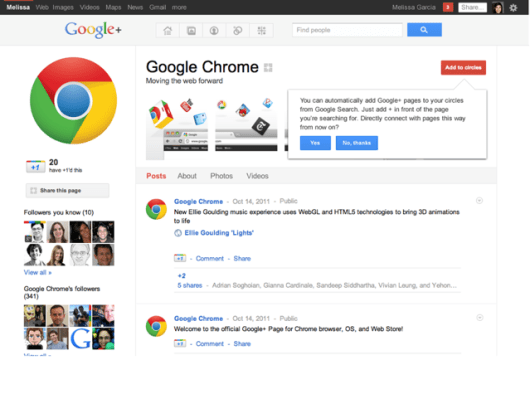Google+ is taking another major step needed toward becoming a full-fledged Facebook rival: it’s launching Google+ Pages, which allow brands, products, companies, businesses, places, groups, and everyone else to establish a presence on the service. The product is a lot like Facebook Pages, but there’s one major difference: Google is baking some elements of Google+ Pages deep into its bread-and-butter search product.
It’s been a rocky road getting here. As you may recall, when Google+ first launched, Google asked brands and publishers not to create pages for their own sites, promising that there would be an official solution coming shortly. Not everyone heeded Google’s request (and, in hindsight, TechCrunch shouldn’t have either), but rather than apply its own rules, Google started making exceptions. A lot of people got upset, a new TechCrunch employee was spawned (and unceremoniously banned), and Google SVP Vic Gundotra later went on to say that the ordeal “was probably a mistake“.
Anyway. Now Google+ Pages are officially launching, and it’s good news all around.
I haven’t gotten to use the new Pages feature yet, but Bradley Horowitz, VP of Product and one of heads of the Google+ project, walked me through a set of slides outlining how they’re created and how users will engage with them.
The first thing Horowitz did was to rattle off some stats: the service launched a little over 100 days ago, now has 40 million users and 3.4 billion photos uploaded, and has launched over one hundred new features. Not a bad start. Onto the Pages.
If you’ve established a personal Google+ profile before, then the features offered through a Page will be familiar. You can place people into Circles, which lets you share content with specific sets of users. You can launch video hangouts, which lets you have face-to-face conversations with your followers. And the Pages work through the site’s mobile app.
But Google has made some key tweaks. The first is that a Page cannot add someone to a circle until that user has already added the page to one of their circles. In other words, a Page can’t start sending you messages until you’ve elected to add them to one of your circles. Another key change: the content on a Page defaults to public (as opposed to ‘My Circles’ for personal profiles) and Pages can’t share with extended circles.
And then there’s the feature that leads to my biggest gripe: Pages have both a +1 button and an ‘Add to Circles’ button. The latter is what permits the Page to start sending you updates. And the +1 button? It does essentially nothing, at least as far as users are concerned.
Yes, your +1 recommendation might show up in a friend’s search query at some point, but that’s not exactly a strong incentive. So what’s the point? Horowitz acknowledges that the +1 button is still a bit opaque, but says “we’re not done with the full realization with what happens” when users click on it, and that we can expect some big things coming soon. He adds that the +1 buttons embedded on a your homepage and your Google+ Page are linked (in other words, if you +1 TechCrunch.com, that’s the same as +1’ing our TechCrunch Google+ Page).
I still think the choice between two buttons is going to confuse the heck out of users, though.
And, finally, there’s the integration with search, which was foreshadowed several weeks ago. For many years, Google Search allowed users to create advanced queries using the ‘+’ operator, which allows you to find results that include an exact term. Then, much to the chagrin to many advanced users, Google announced that it was deprecating the feature.
Today, we find out why: when a user goes to Google and types in ‘+TechCrunch’, they’re asked if they’d like to add TechCrunch to one of their Google+ circles. If they say yes, then this behavior becomes automatic: I could type in +Harry Potter + Android and immediately start following the Pages for both of those pages, assuming they existed. Of course, this behavior isn’t exactly natural. But Horowitz points out that brands could start advertising it — it’s not hard to imagine a trailer closing with ‘+MovieTitle’, the same way they do with the ‘Like us on Facebook’ badges.
Google is describing this feature as Direct Connect to the brands it’s working with. If you want to set it up, you need to create your Google+ Page, then add a snippet of code to the associated official website of your brand (or publisher, or whatever). Once Google’s crawlers ‘see’ this code, which may take a while, the connection will be verified and users will be able to use the ‘+’ feature in Google search.
Update: Apparently only some users can create Google Pages for the time being — you can see if your account is enabled right here.

